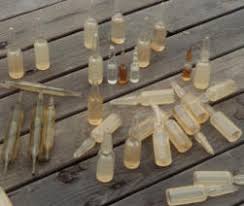
Shipwrecks are often considered time capsules that allow archaeologists to get a glimpse of a specific moment in the past. However, by looking at artifact assemblages on a shipwreck, archaeologists are able to grasp a better understanding of what was important to people at that time. One site that serves as a case study is Constellation, a ship that wrecked just off the coast of Bermuda. The wreck of Constellation lies over top of the American Civil War blockade runner Montana (Huber 2000:87). A large portion of the cargo consisted of over 400,000 glass ampoules that contained a variety of medicines in them. These medicines included morphine, adrenaline, opium, anti-tetanus serum, and penicillin (Bermuda Maritime Museum, 2018). The information that can be gained from studying why ampoules were such a large portion of the cargo is relevant to understanding the culture of Constellation‘s era.
Constellation was a four-masted schooner that measured 187 feet long, with a width of 38 feet, and a depth of 18 feet. The ship was listed at 1,034 tons and was capable of carrying a cargo of 2,000 tons. Constellation was used in several different ways throughout its career. It initially served in the coastal fleet of Crowell and Thurlow from 1922-1925.In 1932 the ship was refitted and converted to serve as a nautical school but was put up for sale the following year when the school failed. In 1936 Constitution carried a group in search of the gold lost by a ship off the coast of Cape Charles, but the voyage proved unsuccessful in finding the gold (Bermuda Maritime Museum Document).
The final stop for Constitution was 1942. The ship was bought by the American Intercontinental Steamship Company to supplement its fleet due to shortages from wartime shipping scarcity (Bermuda Maritime Museum Document). On its voyage to Venezuela, the ship’s steam pumping gear broke down and forced the crew to head to Bermuda for repairs. However, on July 30 as the ship awaited a pilot to enter the harbor it was carried off course by a current and ran aground. The United States Navy was able to salvage much of the cargo, which included over 700 cases of whiskey from the ship before it sank (New York Times, 1943). One of the main items of the cargo that was not recovered and was found among the wreckage by divers is over 400,000 ampoules containing different types of drugs (Bermuda Maritime Museum).
Drug ampoules were a fascinating invention in the history of medicine. “Ampoules are hermetically sealed glass containers that are used to store medicine aseptically’ (Harsiddh Engineering Co.). The use of similar types of containers can be traced back hundreds of years to early Christians who would preserve the blood of dead martyrs in containers. A holy ampoule was used in France to preserve anointing oil used for the coronation of the French monarch beginning in 1131. It was in 1890, that the French pharmacist Stanislaus Limousine developed the first hermetically sealed glass module (Harsiddh Engineering Co.). This invention arose from the need to sustainably preserve injectable solutions for transportation. Manufacturers made ampoules through a process that fired glass into a bottle shape with a tapered neck and sealed the end over a flame after it had been filled with a liquid chemical or biological agent (Harsiddh Engineering Co.).
The wreck of Constellation contained an immensely diverse cargo. However, the most numerous item that can be found on it is the drug ampoule. Hundreds of thousands of these ampoules have been found on the wreck. They contain a variety of drugs including adrenaline, penicillin, and morphine among others (Bermuda Maritime Museum). Many of the drugs found in the ampoules were opiates, such as penicillin, morphine, and opium. These drugs served several purposes, but their functions mainly centered on pain relief and treating illnesses (Brook, 2017: 50). During this period, World War II was underway, and the demand for medical drugs would have been in high demand. The success that morphine had in relieving pain made it a particularly useful drug for injured soldiers during wars (Le Fanu, 2007). That explains why so many ampoules were included among the cargo. The fact that ampoules are small and compact to store would contribute to the larger number of this item type compared to other larger types of cargo that were also found on the wreck of the ship.
The massive amount of these ampoules and their small size also made them very attractive targets for divers to loot and keep as souvenirs. Several of the ampoules on the wreck of Constellation contained drugs that were still active, and the removal of these ampoules by tourist divers led to major issues with customs (Bernews 2013).
BIBLIOGRAPHY
BERMUDA ATTRACTIONS
The Constellation Sunk in Bermuda Waters on July 30, 1943. Bermuda Attractions. <https://www.bermuda-attractions.com/bermuda_000047.htm> Accessed 10 April.
Bermuda Maritime Museum
2018 BMM Vessel Information. Bermuda Maritime Museum. Spring 2018.
Bernews
2013 Exploring Bermuda’s Most Famous Shipwreck. Bernews. <http://bernews.com/2013/03/exploring-bermudas-most-famous-shipwreck/> Accessed 10 April 2018.
Brook, Carolina, Jessica Bennett, and Sukumar Desai.
2017 The Chemical History of Morphine: An 8000-year Journey, from Resin to de-novo Synthesis. Journal of Anesthesia History. 3:2 50-55. 1 April 2017.
Harsiddh Engineering Co.
2018 History of Ampoules and their Filling and Sealing Machine Techniques. Harsiddh Engineering Co.
Huber, Joyce and Jon Huber
2000 Best Dives of the Bahamas and Bermuda, Florida Keys, Turks and Caicos. Hunter Publishing, Inc. Lenoir, NC.
Le Fanu, James
2007 To treat pain in war, morphine is unrivalled. The Telegraph. 5 August 2007 <https://www.telegraph.co.uk/news/uknews/1559481/To-treat-pain-in-war-morphine-is-unrivalled.html) Accessed 4 April 20018.
New York Times
1943 Ship Wrecked in Bermuda: Four-Masted Schooner Constellation is a Total Loss. New York Times. 15 August, New York, NY.
ScienceSourceimages
2018 Drug Ampoules. ScienceSourceimages. <https://www.sciencesource.com/archive/Drug-ampoules-SS2164584.html#/SearchResult&ITEMID=SS2164584> Accessed 10 April 2018.